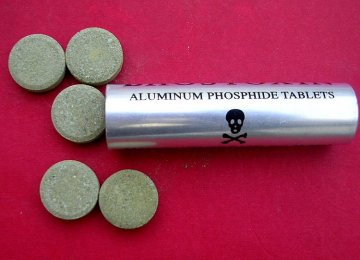Buying and selling aluminium phosphide, a fumigant, known colloquially in Iran as "Rice Tablet", has been declared illegal since 2006.
Since then, the Agriculture Ministry has been tasked with supervising its distribution strictly among farmers. However, AIP is still illegally—yet easily—purchased throughout the country.
Nasser Khosro Street in downtown Tehran has garnered an ill reputation nationwide as the hub for illegal drugs and hard-to-obtain medicines, and AIP is usually sold there.
Aluminium phosphide, used as a fumigant for stored cereal grains and sold under various brand names such as QuickPhos and Celphos, is highly toxic, especially when consumed from a freshly opened container.
Aluminum phosphide poisoning is one of the major causes of suicidal deaths throughout the world, particularly in northern India; however, the number of poisoning incidents, intentional or accidental, from AIP in Iran is quite high.
Toxicity by AIP is caused by the release of phosphine gas. After ingestion, toxicity occurs within a few minutes. The major lethal consequence of AIP ingestion is profound circulatory collapse, fluid loss, and adrenal gland damage. The signs and symptoms are non-specific, dose dependent and evolve with the passage of time.
Nasser Khosro Street and its tiny alleys is studded with drug peddlers with criminal records longer than a fantasy novel, who sell AIP pills (and other drugs) if the price is right.
"Poor implementation of the ban rubbishes its effectiveness," Sohrab Salim Zadeh, a lawyer, told YJC.
Unfortunately, trade in illegal medicine in Iran is poorly monitored; tramadol (used for quitting drug addiction), lethal potassium cyanide, abortion drugs and AIP are easily accessible and are commonly used to commit suicide.
The 16% surge of AIP poisoning in the year March 2016-17, with Tehran registering the highest number of deaths (149), again highlights the need for stronger and effective measures to check and reverse the trade of illegal medicine.
Despite the fact that Iran's suicide rate is 4 or 5 individuals in every thousand people and much lower than the global rate (11 or 12 in every 1,000 individuals) the high number and the young age of those taking their own lives, especially in the western provinces is causing concern.
Globally, the suicide rate among those above 70 years is three times the 15-24 age bracket. However, in Iran suicide among young people is 70% higher than the elderly population.
On the other hand, the suicide rate for the western province of Ilam is 16 times the national rate—71 cases in every 1000 individuals—followed by Lorestan and Kermanshah.






Add new comment
Read our comment policy before posting your viewpoints